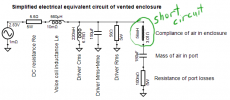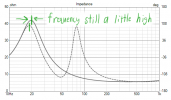Warning: This is a very narrowly focused thread. Please read all the content and be prepared to offer evidence for any new claims. Thanks! Rick
In my thread about Understanding Vented Speaker Impedance, I had used some definitions for the maxima and minima that came from the BassBox Pro manual. Here is a snippet from the online manual for reference:

As you can see the following are defined as follows:
fSB = (fL * fH) / fB where fSB is the resonance frequency for the driver for the air-load mass presented by the enclosure.
While this all seems straightforward, was left feeling it really did not help resolve the question over the Bassbox definition for the first peak (fL). Small's work includes some simplified electrical circuits analogs for a vented speaker. For brevity, I am not citing those here. Later, a more detailed model is supplied as you will see.
While have diverse engineering experience, am not an experienced electrical engineer and was unsure of whether I could get an answer from Bassbox creators after all these years, so started to search around the Internet for more detailed design vented speaker analysis and discovered the content was surprisingly inconsistent and weak. As you might expect, most of what I found was focused on the box resonance (fB) as it is the most fundamental parameter. As I had done, many were relying on one or more software packages to help with vented box design. So, I turned to my network for some expertise...
I sought some more contemporary help from the creator of VituixCAD (Kimmo Saunisto) and @Justin Zazzi who is working on his master degree in Acoustics and is on the Directiva r2 team. The initial part of this thread is a summary of the exchange between the member (@witwald) who challenged the Bassbox definition, Kimmo, Justin and I.
Normally would prefer to split this into a few posts, I have found that this can disrupt continuity, so apologize in advance for the long post. @witwald's original question was "Doesn't the impedance minimum between the two low-frequency impedance peaks correspond to the port tuning frequency? " My short response was yes, but later pointed out this seemed to be in conflict with the Bassbox definition for the first peak. I agreed, so made some attempts to define. fL was proposed, but I was looking something more meaningful than frequency Lower. He later found that the fL peak corresponded to back EMF from the woofer. While progress, I wanted to know what caused the back EMF?
Here is where I consulted Kimmo and he responded with the following model:

...(By the way) || is parallel connection, + is series connection

END OF Kimmo response
Later Kimmo supplied a VituixCAD project file for the model which is attached. I shared this with the group and will share my takeaways in my next post.
Expect that others in the group as well as the broader ASR membership will add to the thread discussion and hopefully drive towards a better understanding of vented speaker design.
In my thread about Understanding Vented Speaker Impedance, I had used some definitions for the maxima and minima that came from the BassBox Pro manual. Here is a snippet from the online manual for reference:
As you can see the following are defined as follows:
- The first peak (maxima) is the resonance of the vents
- The minima (in the middle) is the system resonance of the box
- The second peak is the resonance of the driver in the box
fSB = (fL * fH) / fB where fSB is the resonance frequency for the driver for the air-load mass presented by the enclosure.
While this all seems straightforward, was left feeling it really did not help resolve the question over the Bassbox definition for the first peak (fL). Small's work includes some simplified electrical circuits analogs for a vented speaker. For brevity, I am not citing those here. Later, a more detailed model is supplied as you will see.
While have diverse engineering experience, am not an experienced electrical engineer and was unsure of whether I could get an answer from Bassbox creators after all these years, so started to search around the Internet for more detailed design vented speaker analysis and discovered the content was surprisingly inconsistent and weak. As you might expect, most of what I found was focused on the box resonance (fB) as it is the most fundamental parameter. As I had done, many were relying on one or more software packages to help with vented box design. So, I turned to my network for some expertise...
I sought some more contemporary help from the creator of VituixCAD (Kimmo Saunisto) and @Justin Zazzi who is working on his master degree in Acoustics and is on the Directiva r2 team. The initial part of this thread is a summary of the exchange between the member (@witwald) who challenged the Bassbox definition, Kimmo, Justin and I.
Normally would prefer to split this into a few posts, I have found that this can disrupt continuity, so apologize in advance for the long post. @witwald's original question was "Doesn't the impedance minimum between the two low-frequency impedance peaks correspond to the port tuning frequency? " My short response was yes, but later pointed out this seemed to be in conflict with the Bassbox definition for the first peak. I agreed, so made some attempts to define. fL was proposed, but I was looking something more meaningful than frequency Lower. He later found that the fL peak corresponded to back EMF from the woofer. While progress, I wanted to know what caused the back EMF?
Here is where I consulted Kimmo and he responded with the following model:
...(By the way) || is parallel connection, + is series connection
END OF Kimmo response
Later Kimmo supplied a VituixCAD project file for the model which is attached. I shared this with the group and will share my takeaways in my next post.
Expect that others in the group as well as the broader ASR membership will add to the thread discussion and hopefully drive towards a better understanding of vented speaker design.
Attachments
Last edited:



